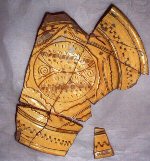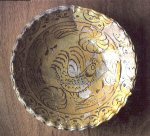In north Devon, pottery was made in the medieval period to supply local needs. As a result of increased trade with Europe, new techniques of potting were introduced. A plain glazed pottery was being made in north Devon by 1600 and continued to be made throughout the 17th century. The decorated wares were made in the sgraffito technique. The two main centres of pottery production were Barnstaple and Bideford (Grant 1983).
Beauvais ware was exported to Devon in the late 16th century. The potters in north Devon used the double firing method, the same technique as in the Beauvaisis. This was the only place in south-west England to do so, and it has been suggested that a potter or potters from the Low Countries had introduced the technique, as some of the designs are similar to those found on Huguenot and Low Countries pottery. In 1607 refugee Protestant Flemings and Frenchmen were reported in Barnstaple. There was a flourishing trade at that time, with many ships making journeys direct from Bideford and Barnstaple to parts of the Netherlands and northern France (ibid).
The fabric is a dull pinkish red with a grey core. The vessels are given two firings, one before glazing and one after. The grey core is caused by incomplete oxidation during the firing. The vessels are coated in a white kaolin slip and the designs are scratched through the wet slip to reveal the clay beneath. The lead glaze varies in tone from honey to a dark greenish amber, and over the slip the glaze colour range is from lemon to a brown-yellow. Over the incised design, the glaze is coloured a rich mahogany brown or dark amber (Watkins 1960, 41-42).
The forms cover a wide range of vessels including plates, platters and chargers, baluster wine cups, mugs, jugs, bowls and chamber pots. The motifs used in decoration are varied and never occur in any one combination more than once. There are two main categories, geometric and floral. On the majority of plate rims the geometric decoration is of hastily drawn spirals and guilloches. The centres may have circles within squares, enclosing compass-drawn petals, or within a series of swags embellished with lines. Other vessels have simpler geometric patterns. The floral designs include elaborate and intricate stylised floral and vine motifs, tulips, sunflowers, leaves, tendrils, hearts and 4-petalled flowers (ibid, 43).
These designs are unique in comparison with other 17th-century English pottery. It is suggested that the geometrical and spiral patterns have their inspiration in Moorish decorative motifs. The Christian symbols, in particular tulips, sunflowers and hearts, are also seen on contemporary west of England furniture, pewter and embroidery. In addition they are seen on the carved chests and crewel work of Puritan New England. Watkins considers there is much circumstantial evidence to make a connection between north Devon sgraffito ware manufacture and design and the influx of Huguenot and Netherlands Protestant artisans into south and south-west England (ibid, 43).
North Devon sgraffito plates have been found in excavations in Castletown, Isle of Man, dated to the 17th century. These are the first sgraffito sherds from north Devon recovered in the Isle of Man to date (Davey et al. 1996, 78). A dish was found in Chester dated to the end of the 17th century (Davey and Rutter 1977, 28) and an almost complete dish was recovered from Sefton Old Hall in Merseyside (Davey 1991, 136).

Figure 24: North Devon sgraffito plate found at Sefton Old Hall, Merseyside
The north Devon industry was directed principally towards export. It was trading with Ireland as early as 1600, and to America by 1635. Trade was particularly heavy just after the Restoration and was tied to the influential 17th-century west of England commerce with America, in particular with New England, Maryland and Virginia (Watkins 1960, 53). The coastal trade around the Irish Sea was very strong, with cargoes to Chester, Liverpool and Whitehaven, and along the Welsh coast. In the other direction, vessels called at Penzance, the Isles of Scilly and ports on the rivers Exe and Severn (Grant 1983, 93).
Pottery was produced at a kiln in north-east Sussex during the second quarter of the 16th century, approximately 1520-1545. There is strong circumstantial evidence to suggest that a French potter from the Beauvaisis worked at this site: documentary evidence shows that there were Frenchmen working at the earlier furnace and forge on the same site, the pottery has technical and decorative characteristics which link it with the Beauvaisis, and the kiln is not a traditional south-east English type (Freke 1979, 87).
Only 63 sherds with incised decoration were found, out of a total of 177,400 wasters for the site. It was possible to discern three types of decorative motifs: simple parallel lines; wavy lines, usually double or triple; feather and horizontal lines (ibid, 109). The wavy lines were used on the shoulders of jugs or pitchers and the feather motif on lids. The lines were found on both vessel forms (ibid, 109). In addition, 23 fragments of two Beauvais sgraffito plates and a bowl were excavated in single and double slip.
Other vessel forms from the site include jugs, cooking pots, storage jars, chafing dishes, mugs, plates and bowls. The glaze was lead oxide, with copper or iron added as colourant only rarely (ibid, 110).
Donyatt in Somerset had a flourishing post-medieval pottery industry from the mid-17th century to the 20th century. There are considerable documentary sources to provide information about some of the potting families, indicating that the businesses were small family concerns which were passed on from generation to generation (Coleman-Smith and Pearson 1988).
There was some previous pottery production at Donyatt, the earliest evidence dating to the 13th century. By the 16th century sgraffito decoration was adopted on a range of wares, including jugs, cups and mugs. A white slip was applied over the vessel. The sgraffito technique was the most popular form of decoration in the West Country in the 17th and 18th centuries. Forms produced at Donyatt in sgraffito include jugs, cups, dishes, bowls, various storage vessels and other domestic items (ibid).
Some of the decorative motifs show probable foreign influence. The bird motif is probably derived from the French cockerel. The tulip motif is likely to be influenced by the Low Countries. The method of decoration using dotted and combed wet slip on some Donyatt dishes is similar to that for Werra sgraffito (ibid, 391).
A Donyatt-style sgraffito dish dated to the early 17th century was found in Plymouth (Allan and Barber 1992, 230).

Figure 25: Donyatt cockerel dish. Reproduced by kind permission of the publisher, from Excavations in the Donyatt Potteries by R. Coleman-Smith and T. Pearson, published in 1988 by Phillimore & Co Ltd, Shopwyke Manor Barn, Chichester, West Sussex PO20 2BG.
The excavations on the site of Brookhill pottery, Buckley, produced evidence of sgraffito and slip-trailed manufacture in the mid-17th century. The sgraffito forms are of thrown dishes with broad, sloping, concave rims and rilled sides. They are white slip-coated on the interior over a pink-red coarse fabric (Amery and Davey 1979, 55). The designs are found on both sgraffito and slip-trailed wares and are illustrated in Appendix 3. The most common motifs include animals and birds, tulips, leaves and geometric.
© Internet Archaeology
URL: http://intarch.ac.uk/journal/issue16/1/ch7.3.html
Last updated: Wed Mar 24 2004